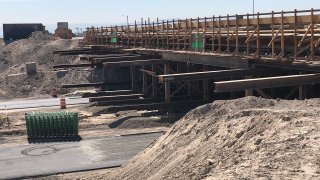
This story is no longer being updated. For the latest updates from Monday's signing ceremony, click here.
The state of California and Mexico will sign an agreement Monday to ensure a new massive port of entry in Otay Mesa be completed by late 2024.
Construction on the $1 billion binational Otay Mesa East Port of Entry project has been underway since 2013. Once completed, the Otay Mesa East Port of Entry will be the second gate in Otay Mesa and the third between San Diego County and Mexico.
Get top local stories in Southern California delivered to you every morning. >Sign up for NBC LA's News Headlines newsletter.
The third port of entry between Tijuana and San Diego is expected to ease transportation woes for commuters between the two countries to improve trade and commerce, and to reduce pollution along the border, according to Caltrans.
The port is estimated to be completed in 2024 and NBC 7 and Telemundo 20 checked out the progress in October of 2020.
At the time, the lot was vacant -- full of mud and dirt -- but will become a transportation hub filled with the latest technology and the ability to reduce wait times at other checkpoints by up to 50%, according to Caltrans. The upgraded POE will include a new border wait time detection system, advanced traveler information to improve route planning and an optimized port capacity.
The massive project is currently underway on a 100-acre plot -- about the same size as Disneyland.
U.S. & World
News from around the country and around the globe
Officials from Caltrans affirm that the innovative gate will be built according to the public's need, depending on demand.
"The idea is for the gate to grow, ”said Mario Orso, Border Corridor Director for Caltrans, District 11 told Telemundo 20 in Spanish. “For opening day, it may be 10 lanes, but the innovativeness of this gate is that it's designed in a way that you would not have to knock it down or make a new one."
Unlike the rest of the ports of entry between California and Mexico, this one will have a toll fee; it will not be located at the U.S. Customs and Border Protection inspection booths, but on the United States bridge. The cost has not yet been specified and could vary between commercial and cargo cars.
Caltrans believes drivers will see the benefit of port because it is expected to speed up the border crossing wait time.
More details about the agreement will be released Monday.



